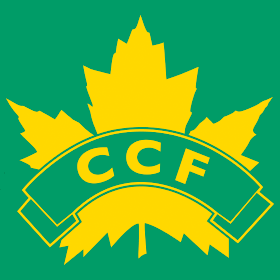
The Co-operative Commonwealth Federation was a federal democratic socialist and social-democratic political party in Canada. The CCF was founded in 1932 in Calgary, Alberta, by a number of socialist, agrarian, co-operative, and labour groups, and the League for Social Reconstruction. In 1944, the CCF formed one of the first social-democratic governments in North America when it was elected to form the provincial government in Saskatchewan.

Herbert W. Greenfield was a Canadian politician and farmer who served as the fourth premier of Alberta from 1921 until 1925. Born in Winchester, Hampshire, in England, he immigrated to Canada in his late twenties, settling first in Ontario and then in Alberta, where he farmed. He soon became involved in the United Farmers of Alberta (UFA), a farmers' lobby organization that was in the process of becoming a political party, and was elected as the organization's vice president. Greenfield did not run in the 1921 provincial election, the first provincial general election in which the UFA fielded candidates, but when the UFA won a majority in the Legislature in that election he was chosen by the UFA caucus to serve as Premier. Like most of the UFA caucus, Greenfield had no experience in government and he struggled in the position.
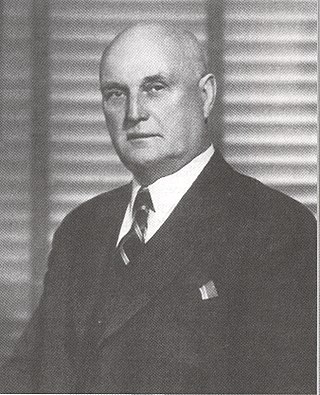
Charles Stewart, was a Canadian politician who served as the third premier of Alberta from 1917 until 1921. Born in Strabane, Ontario, in then Wentworth County, Stewart was a farmer who moved west to Alberta after his farm was destroyed by a storm. There he became active in politics and was elected to the Legislative Assembly of Alberta in the 1909 election. He served as Minister of Public Works and Minister of Municipal Affairs—the first person to hold the latter position in Alberta—in the government of Arthur Sifton. When Sifton left provincial politics in 1917 to join the federal cabinet, Stewart was named his replacement.

The Nonpartisan League (NPL) was a left-wing political party founded in 1915 in North Dakota by Arthur C. Townley, a former organizer for the Socialist Party of America. On behalf of small farmers and merchants, the Nonpartisan League advocated state control of mills, grain elevators, banks, and other farm-related industries in order to reduce the power of corporate and political interests from Minneapolis and Chicago.
The Progressive Party of Canada, formally the National Progressive Party, was a federal-level political party in Canada in the 1920s until 1930. It was linked with the provincial United Farmers parties in several provinces, and it spawned the Progressive Party of Saskatchewan, and the Progressive Party of Manitoba, which formed the government of that province. The Progressive Party was part of the farmers' political movement that included federal and provincial Progressive and United Farmers' parties.
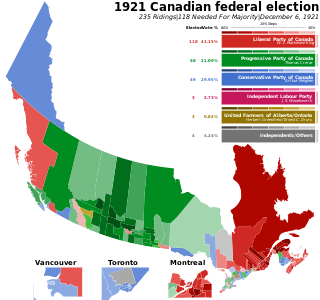
The 1921 Canadian federal election was held on December 6, 1921, to elect members of the House of Commons of Canada of the 14th Parliament of Canada. The Union government that had governed Canada through the First World War was defeated, and replaced by a Liberal government under the young leader William Lyon Mackenzie King. A new third party, the Progressive Party, won the second most seats in the election.
There have been various groups in Canada that have nominated candidates under the label Labour Party or Independent Labour Party, or other variations from the 1870s until the 1960s. These were usually local or provincial groups using the Labour Party or Independent Labour Party name, backed by local labour councils made up of many union locals in a particular city, or individual trade unions. There was an attempt to create a national Canadian Labour Party in the late 1910s and in the 1920s, but these were only partly successful.

The United Farmers of Alberta (UFA) is an association of Alberta farmers that has served different roles in its 100-year history – as a lobby group, a successful political party, and as a farm-supply retail chain. As a political party, it formed the government of Alberta from 1921 to 1935.

The 1917 Alberta general election was held on 7 June 1917 to elect members of the Legislative Assembly of Alberta. The Liberals won a fourth term in office, defeating the Conservative Party of Edward Michener.

The 1921 Alberta general election was held on July 18, 1921, to elect members to the 5th Alberta Legislative Assembly. It was one of only five times that Alberta has changed governments.

The 1926 Alberta general election was held on June 28, 1926, to elect members of the Legislative Assembly of Alberta. The United Farmers of Alberta government that had first been elected in 1921 was re-elected, taking a majority of the seats in the Alberta Legislature. Herbert Greenfield had resigned as United Farmers leader and premier, and John E. Brownlee led the UFA to this second election victory, increasing the UFA's number of seats.
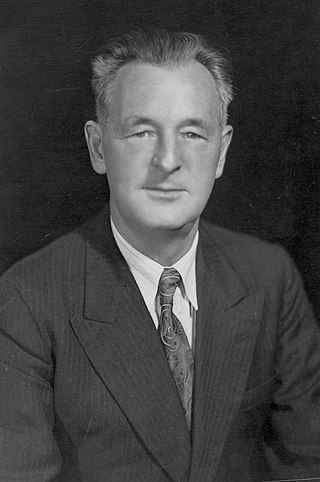
William Irvine was a Canadian politician, journalist, and clergyman. He served in the House of Commons of Canada on three occasions, as a representative of Labour, the United Farmers of Alberta, and the Co-operative Commonwealth Federation. During the 1920s, he was active in the Ginger Group of radical Members of Parliament (MPs).
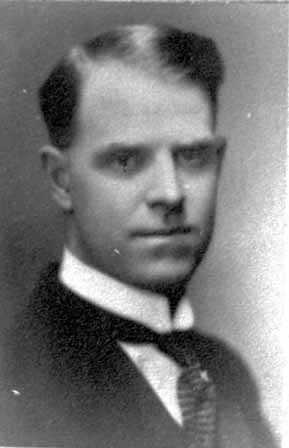
Joseph Tweed Shaw was a Canadian politician. He served in the House of Commons of Canada from 1921 to 1925 as an independent Labour Member of Parliament (MP), and later became an MLA and leader of the Alberta Liberal Party.

John Whitnah Leedy was the 14th Governor of Kansas, serving 1896 to 1898. He later was active in politics in Alaska and Alberta, Canada.
The Dominion Labor Party (Alberta) was a minor political party. It was founded on June 11, 1918 when Edmonton's Labour Representation League renamed itself the Alberta wing of the DLP. Its executive included Mr. Marshall, Mr. Mercer, Mr. Dan Knott, later mayor of the city, White, Findlay and Farmilo, and Elmer Roper, later mayor Edmonton.

Lorne Proudfoot was a farmer, teacher and a provincial politician from Alberta, Canada. He served as a member of the Legislative Assembly of Alberta from 1921 to 1935 sitting with the United Farmers caucus in government.
Floyd Albin Johnson (1908–1974) was a Canadian politician who was the last leader of the Alberta Co-operative Commonwealth Federation from 1957 until 1962.
Claresholm was a provincial electoral district in Alberta mandated to return a single member to the Legislative Assembly of Alberta using the first past the post method of voting from 1909 to 1929.














